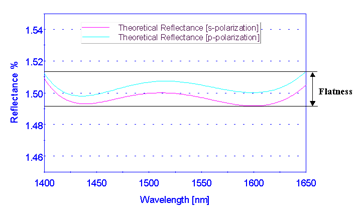Tap Coupler – Beamsplitter Tutorial
Tap couplers filters and beamsplitters are used to reflect a specific percentage of incident light over a broad wavelength range and for a specified angle of incidence. Beamsplitters and tap couplers can be specified to work for both polarized or non-polarized light and the reflected and transmitted beams can either be polarized or non-polarized as desired.
Note that it is important to ensure that there is no substrate etalon ripple effect present as this will effect the overall flatness.

Flatness [%]
This defines the maximum variation of the transmittance or the reflectance over the wavelength range of interest (see above Figure)..
Polarization Dependent Loss (PDL) [dB]
Polarization Dependent Loss (PDL) can be defined as the maximum change observed in transmittance or reflectance at a given wavelength as the light is cycled through all possible polarization states. The PDL can be calculated based on the difference between the s- and p-polarization states of light, i.e.,
Transmittance PDL(l) [dB] = Ts(l) [dB] – Tp(l) [dB]
Substrate Etalon Ripple Effect [dB]
With coherent light, any type of filter can act as a Fabry-Perot etalon if the two surfaces of the filter are sufficiently parallel and if the secondary surface of the filter is not anti-reflection (AR) coated. If this is the case, then there will be an etalon ripple superimposed on the desired filter shape. For a substrate thickness of 1 mm, the resultant ripple will have a period of ~0.8 nm at a wavelength of 1550 nm. The magnitude of the ripple will depend on the reflectance of the two sides of the filter and the substrate parallelism. This etalon ripple can be minimized by introducing a sufficient wedge angle (> 0.2 degs) or by depositing a very good AR coating on the secondary surface.
